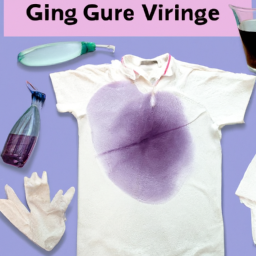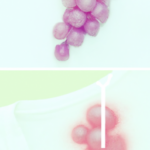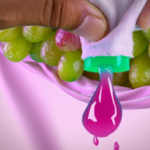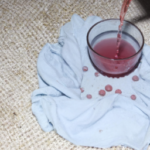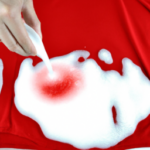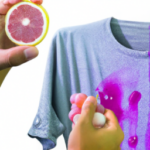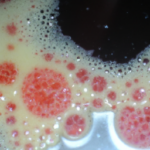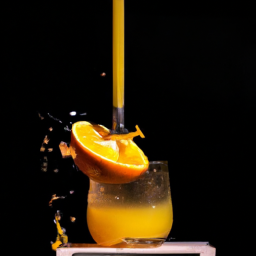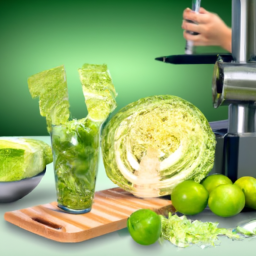As a fan of red wine and grape juice, I understand the frustration of spilling it on my clothes or furniture. The deep purple color of grape juice can be tough to remove, leaving unsightly stains that can ruin fabrics and upholstery. However, with the right techniques and a little elbow grease, it is possible to successfully remove grape juice stains.
The key to successfully removing a grape juice stain is to act fast. The longer the stain sits, the harder it will be to remove. In this article, I will share with you my tried and tested methods for getting grape juice stains out of clothing, carpet, and upholstery.
From blotting the stain to using household items like vinegar and dish soap, I will guide you through the process step by step, so you can save your favorite clothes and furniture from ruin.
Key Takeaways
- Act fast and blot the stain with a clean, dry cloth or paper towel to prevent it from setting in.
- Use white vinegar, baking soda, or specialized stain removers to treat the stain and avoid hot water as it can set the stain deeper.
- Soak fabric in vinegar to loosen remaining stain particles and use baking soda or dish soap to break down remaining residue.
- Use hot water and mild detergent to wash the stain, air dry the material, and repeat the washing process if necessary.
Act Fast: Tackle the Stain Immediately
You’ve spilled grape juice on your shirt, so grab a cloth and start blotting the stain before it sets in deeper.
Preventing stains in the first place is the best course of action, but if it’s too late for that, be sure to act fast. Time sensitive action is key when it comes to removing grape juice stains from clothing or other fabrics.
Blot the stain: remove excess juice. This will help prevent the stain from spreading and setting in. Use a clean, dry cloth or paper towel and press down gently on the stain. Avoid rubbing, as that can make the stain worse. The goal is to lift as much of the juice out of the fabric as possible.
Blot the Stain: Remove Excess Juice
First, try dabbing at the excess liquid with a clean cloth or paper towel to prevent the stain from spreading further into the fabric. Be gentle when blotting, as pressing too hard can cause the grape juice to penetrate deeper into the fibers. If the stain is on a delicate fabric, like silk or wool, be particularly careful not to damage the material.
Here are some prevention tips and alternative cleaning methods to consider:
-
Use white vinegar: Mix one tablespoon of white vinegar with two cups of cold water. Dab the solution onto the stain and let it sit for 10-15 minutes before blotting with a clean cloth.
-
Try baking soda: Create a paste with baking soda and water and apply it directly onto the stain. Let it sit for a few minutes before gently scrubbing and rinsing with cold water.
-
Use a specialized stain remover: Look for a stain remover specifically designed for grape juice stains. Follow the instructions on the label and test the product on a small, inconspicuous area of the fabric before using it on the entire stain.
-
Avoid hot water: Hot water can set the stain into the fabric, making it more difficult to remove. Stick to cold water only when trying to remove grape juice stains.
Now that you’ve blotted the excess liquid and considered some alternative cleaning methods, it’s time to move on to the next step: rinsing the stain with cold water.
Rinse with Cold Water
After blotting the excess grape juice, it’s important to rinse the stained area with cold water. Cold water can effectively remove any residue left behind by the juice and prevent the stain from setting in further. The benefits of using cold water include its ability to prevent the stain from spreading and setting in deeper.
Additionally, cold water can help to lift the stain from the fabric, making it easier to remove. It’s important to rinse the affected area as soon as possible. The longer the juice sits on the fabric, the more difficult it will be to remove.
Timing is crucial when rinsing, as waiting too long can allow the stain to set in and become permanent. Once the area has been rinsed thoroughly, it’s time to move on to the next step – applying a stain remover.
Apply Stain Remover
Now it’s time to tackle that stubborn grape juice stain by applying a potent stain remover that’ll leave your fabric looking as good as new. Before you begin, it’s important to test the stain remover on an inconspicuous area of the fabric to ensure it won’t cause any discoloration or damage.
Once you’re ready to proceed, apply the stain remover directly onto the stain and let it sit for the recommended amount of time, as specified on the product label. There are alternative methods you can try if the stain doesn’t come out with the first application.
For example, you can try using a mixture of baking soda and water, or a solution of hydrogen peroxide and dish soap. However, it’s important to exercise caution when using these methods, especially on delicate fabrics, as they may cause further damage. With the right precautions, you can successfully remove a stubborn grape juice stain and restore your fabric to its original condition.
Moving on to the next step, soaking the fabric in vinegar can help to loosen any remaining stain particles and prepare the fabric for washing.
Soak in Vinegar
To prepare your fabric for washing, you’ll want to give it a good soak in white vinegar, which is a natural and effective cleaning agent.
Vinegar is a versatile household item that’s been used for cleaning and disinfecting for centuries. Its acidic properties make it a powerful cleaner, capable of breaking down even the toughest stains and grime.
One of the benefits of using vinegar for cleaning is that it’s safe and non-toxic. Unlike harsh chemical cleaners, vinegar is gentle enough to use on delicate fabrics and surfaces.
In addition to its cleaning properties, vinegar also has alternative uses around the house, such as removing odors, unclogging drains, and even repelling insects.
So, give your grape juice-stained fabric a soak in vinegar and enjoy the fresh and clean scent it leaves behind.
Now, let’s move on to the next step in removing grape juice stains, which is using baking soda.
Use Baking Soda
Using baking soda is like sprinkling a magical powder on your stained fabric, creating a fizzy reaction that lifts away dirt and grime. Not only is baking soda an effective stain remover, but it also has other benefits. It’s non-toxic, inexpensive, and easily available in most households.
If you don’t have any baking soda on hand, there are some alternatives you can use. Borax, salt, and cornstarch are all effective substitutes for baking soda. However, baking soda remains the most popular choice due to its versatility and effectiveness.
Transitioning into the subsequent section about trying hydrogen peroxide, I’d recommend using baking soda as a first attempt at removing grape juice stains. If the stain persists, try hydrogen peroxide.
Try Hydrogen Peroxide
Hydrogen peroxide can be a powerful stain remover for various materials, including grape juice stains on clothing and carpets. When hydrogen peroxide comes into contact with the stain, it undergoes a chemical reaction that breaks down the pigment molecules and lifts them from the fabric.
This reaction can be accelerated by heat, so it’s best to apply the hydrogen peroxide solution to the stain as soon as possible and then expose it to sunlight or use a hair dryer to speed up the process. However, it’s important to take safety precautions when using hydrogen peroxide as a stain remover.
It’s a strong oxidizer that can cause skin irritation or discoloration, so it should be handled carefully and only used in a well-ventilated area. Additionally, it shouldn’t be mixed with other cleaning agents, such as bleach or ammonia, as this can create a dangerous chemical reaction. With these precautions in mind, hydrogen peroxide can be an effective solution for removing grape juice stains from your clothes or carpets.
If hydrogen peroxide doesn’t completely remove the stain, the next step is to use dish soap to break down any remaining residue.
Use Dish Soap
Employing dish soap can be a viable method for eliminating any remaining residue from the stained material. While hydrogen peroxide is effective in getting rid of grape juice stains, it may leave a residue that requires further cleaning. This is where alternative methods such as dish soap come in handy.
Dish soap effectiveness lies in its ability to break down organic stains such as grape juice. It contains enzymes that can break down the stain and lift it from the fabric. To use this method, mix a small amount of dish soap with warm water and apply it to the stained area. Let it sit for a few minutes before rinsing it off with cool water. Repeat the process until the stain is completely gone.
Once the stain is gone, you can wash the material in hot water to remove any remaining residue.
It’s important to note that not all dish soaps are created equal. Some may contain harsh chemicals that can damage the fabric. Use a mild dish soap that is gentle on the material.
With proper use of dish soap, you can effectively remove grape juice stains without damaging the fabric.
Wash in Hot Water
Now it’s time to tackle the next step in removing the pesky grape juice stain – you’ll want to throw the material in the wash with hot water, making sure to use a mild detergent that won’t harm the fabric. Hot water is essential in removing grape juice stains as it helps to break down the pigments. However, if the material is delicate or prone to shrinkage, it’s best to avoid using hot water and opt for lukewarm instead.
Preventing stains is always the best option, but accidents happen. Different types of grape juice can also affect the success rate of removing the stain. For example, red grape juice stains are notoriously difficult to remove, while white grape juice stains are generally easier to tackle. It’s important to identify the type of grape juice stain before proceeding with the washing process. Remember, prevention is always better than cure, but if a stain does occur, using hot water and a mild detergent is your best bet for removing a grape juice stain.
Now that the material has been washed, it’s time to dry and repeat if necessary.
Dry and Repeat if Necessary
After washing the material with hot water and mild detergent, it’s time to dry it and check for any remaining traces of the pesky grape juice stain. Here are some tips to help prevent future stains and recommended stain removers to use if necessary:
-
Preventing stains: The best way to prevent grape juice stains is to be proactive. If you know that you or someone in your household is prone to spills, try using spill-proof cups or placing a napkin over the cup to catch any excess liquid. You can also try to avoid drinking grape juice near carpets or other materials that can stain easily.
-
Recommended stain removers: If you do end up with a grape juice stain, there are a few recommended stain removers you can try. One option is to use a mixture of baking soda and water to create a paste that you can apply to the stain. Let the paste sit for a few minutes before rinsing it off with cold water. Another option is to use a specialized stain remover, such as OxiClean or Shout. Be sure to follow the instructions on the product carefully and test it on a small, inconspicuous area first to make sure it doesn’t damage the material.
-
Repeat the process: If the stain is still visible after drying, don’t despair. Simply repeat the washing process with hot water and mild detergent, focusing on the stained area. Be sure to check for any remaining traces of the stain before drying the material again.
-
Air dry: When drying the material, avoid using high heat or putting it in the dryer, as this can set the stain. Instead, air dry the material by hanging it up or laying it flat on a clean surface. Once the material is completely dry, check for any remaining traces of the stain and repeat the washing process if necessary.
Frequently Asked Questions
Can I use warm or hot water to rinse the stain instead of cold water?
Using warm water for grape juice stain removal is not recommended as it can cause the stain to set. It’s best to stick to cold water and blot the stain gently. If vinegar is used, precautions should be taken to avoid damaging the fabric.
What type of stain remover should I use for grape juice stains?
When dealing with grape juice stains, alternative methods and DIY solutions can be effective. For instance, mixing vinegar and baking soda to create a paste can remove the stain. Additionally, using a specialized stain remover designed for grape juice stains can also be helpful.
How long should I soak the stained garment in vinegar?
When trying to remove stains with vinegar, it’s important to pre-treat the area with soap before soaking. The length of time needed for soaking will depend on the severity of the stain, but generally 30 minutes should suffice. Vinegar soaking tips can vary depending on the fabric and type of stain, but a little patience and persistence can go a long way in removing stubborn grape juice stains.
Can I use lemon juice instead of vinegar to remove the stain?
As a cleaning expert, I would recommend using vinegar to remove grape juice stains. However, if you don’t have any vinegar on hand, lemon juice can be used as a substitute. There are also alternative methods such as using baking soda or hydrogen peroxide.
Should I avoid using fabric softener when washing the stained garment?
I avoid using fabric softener when washing stained garments, as it can set the stain. Instead, I opt for alternatives like vinegar or baking soda. Fabric softeners have pros and cons, but for stain removal, it’s best to avoid them.
Conclusion
Well, folks, that’s how you get grape juice stains out. It may seem like a daunting task, but with the right tools and techniques, your clothes can look brand new again.
Remember to act fast, blot the stain, rinse with cold water, apply stain remover, soak in vinegar, try hydrogen peroxide, use dish soap, and wash in hot water. Don’t forget to dry and repeat if necessary.
Nowadays, we’ve got all sorts of products and technologies to help us with our laundry problems. However, sometimes the old-fashioned methods still work the best.
With a little patience and elbow grease, you can remove even the toughest grape juice stains. So go ahead and enjoy that glass of grape juice, knowing that you’ve got the power to conquer any stain that comes your way.
Ilana has been a vegan for over 10 years. She originally made the switch for health reasons, but soon found herself becoming more and more passionate about the ethical and environmental implications of a vegan lifestyle. Ilana is the author of The Graceful Kitchen, a blog all about veganism. She loves to cook up delicious and nutritious vegan meals, and share her recipes with others who are interested in leading a cruelty-free life. Ilana is also a strong advocate for using whole foods as the foundation of a healthy diet, and believes that going vegan is one of the best ways to achieve this.
